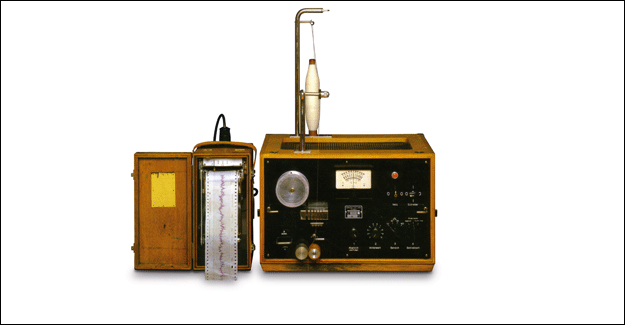USTER Tester Celebrates Its Seventieth Year
USTER Tester Celebrates Its Seventieth Year

The famous USTER® Tester celebrates its 70th anniversary this year, and its unique reputation as a driver of textile quality worldwide is stronger than ever. Even in its earliest version, this remarkable instrument was a big hit with spinning mills, inspiring a new focus on yarn quality. Continuous development throughout the 20th Century saw the USTER® Tester established as essential equipment for the textile laboratory and the word ‘Uster’ become a generic term among mill personnel for evenness testing.
Further progress followed in the new millennium, the USTER® TESTER 6 setting standards even higher by introducing the Total Testing Center – the gateway to integrated quality management of the complete yarn manufacturing process. For most textile professionals, there is really only one evenness tester, now fulfilling its destiny as the undisputed heart of the entire spinning mill. Here, three USTER people describe some of the key development stages.
Peter Hättenschwiler was a 20-year old apprentice, working in the precision engineering department of Zellweger Uster, a well-established and sizeable Swiss company producing a range of textile testing instruments. The year was 1948 and Zellweger, the forerunner of Uster Technologies, was ready to launch the world’s first yarn evenness tester, the USTER® GGP, after four years of development.
Hättenschwiler, now in his 91st year, well remembers assembling this historic instrument: “The GGP® consisted of a capacitive sensor and a diagram recorder, all housed neatly in a state-of-the-art wooden case,” he says. “The device actually looked quite similar to early radios – but it turned out to be a huge success story in the textile industry over the coming decades."
Originating from the USTER company’s search for diversification after the 2nd World War, the GGP® was its first electronic product, incorporating the latest technology of the day. It was soon established as the global standard for yarn evenness, destined to become an indispensable tool for many generations of textile professionals.
Now, in 2018, the USTER evenness tester celebrates its 70th anniversary, marking decades of unprecedented success. Over 16,000 USTER® Testers have so far been sold in 65 countries. And thousands of operators all over the world depend on its key values – the familiar U% and CVm results.
Foundation for USTER® STATISTICS
The USTER® GGP sparked a new interest in evenness testing by spinners, and led to requests for further quality management tools. The response was the publication in 1957 of USTER® STANDARDS, the precursor of USTER® STATISTICS. This listed unevenness data as U% and CV figures for carded and combed yarns, from GGP® test results collated worldwide. For the first time, spinners were able to benchmark their yarn quality against that of other mills, using objective measurements.
Evenness is still an essential quality standard for the industry today – although the number of different yarn parameters included in USTER® STATISTICS has extended over time, in line with the launch of further USTER® instruments for quality improvement. The USTER® Tester itself was developed still further and became even more popular, regarded as ‘the heart of the textile laboratory’.
Best-selling tester ever
Another significant milestone in evenness testing came with the launch of USTER® TESTER 3 at the Paris ITMA in 1987. Rathnam V. Rama, President of Uster Technologies (India), joined the company the year before: “The new third generation USTER® Tester won the product award at the show,” he says. “It was the most talked-about product during ITMA and drew huge crowds of customers to the USTER booth.”
ITMA visitors were impressed by the product design and unique features of the USTER® TESTER 3, which confirmed USTER’s position in the forefront of testing technology. The first hairiness measurement (H) was integrated in the instrument, enabling users to test evenness and hairiness at the same time. It was no surprise that several orders were booked on the spot at that show, for what subsequently became the best-selling evenness tester of all time.
From yarn testing to total mill management
USTER’s future-oriented vision and focus on customer needs has ensured that the innovative pace is continuous, reaching the summit of current technology with the latest USTER®TESTER 6. Starting with the brand-new digital Capacitive Sensor CS, the speed, range and precision of measurements is greater than ever. A new hairiness length (HL) sensor combines with OH results to allow full control over yarn hairiness, while the OM for diameter variation, OI for dust and trash and FA for yarn fineness complete the extended test options.
Gabriela Peters, USTER’s Product Manager Yarn Testing, played a leading role in the creation of the latest USTER® TESTER 6, which was launched at ITMA in Milan in 2015. From its earlier role as an essential laboratory tool, the USTER® Tester in its sixth generation now deserves to be called “the heart of the spinning mill,” she says.
USTER® TESTER 6 incorporates the Total Testing Center, for centralized analysis of data from connected USTER® testing and monitoring instruments. This allows total quality management of the entire spinning mill.
Says Peters: “We wanted a system going beyond data collection. The new Tester must offer new intelligent data analysis, including automatic alarms for each process step. Users also have the benefit of built-in knowledge, provided through Assistant Q. This systematic approach drives timely problem-solving and makes a vital contribution to avoiding quality complaints.”
These continuous outstanding developments underline the USTER® Tester’s status as a leading global brand. USTER® TESTER 6 has also added aesthetic acclaim to its high-tech excellence by winning a prestigious Red Dot Design Award in 2016.



 textileexcellence
textileexcellence 







